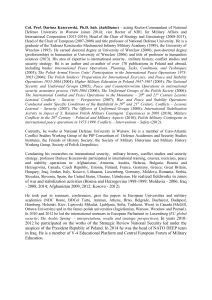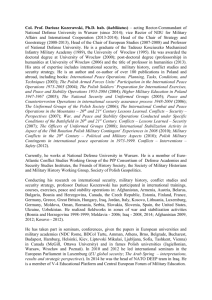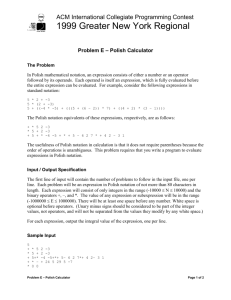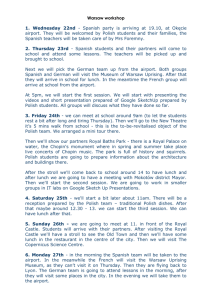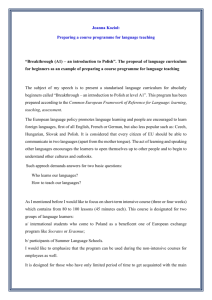PATRON HENRYK SIENKIEWICZ Henryk Sienkiewicz was born in
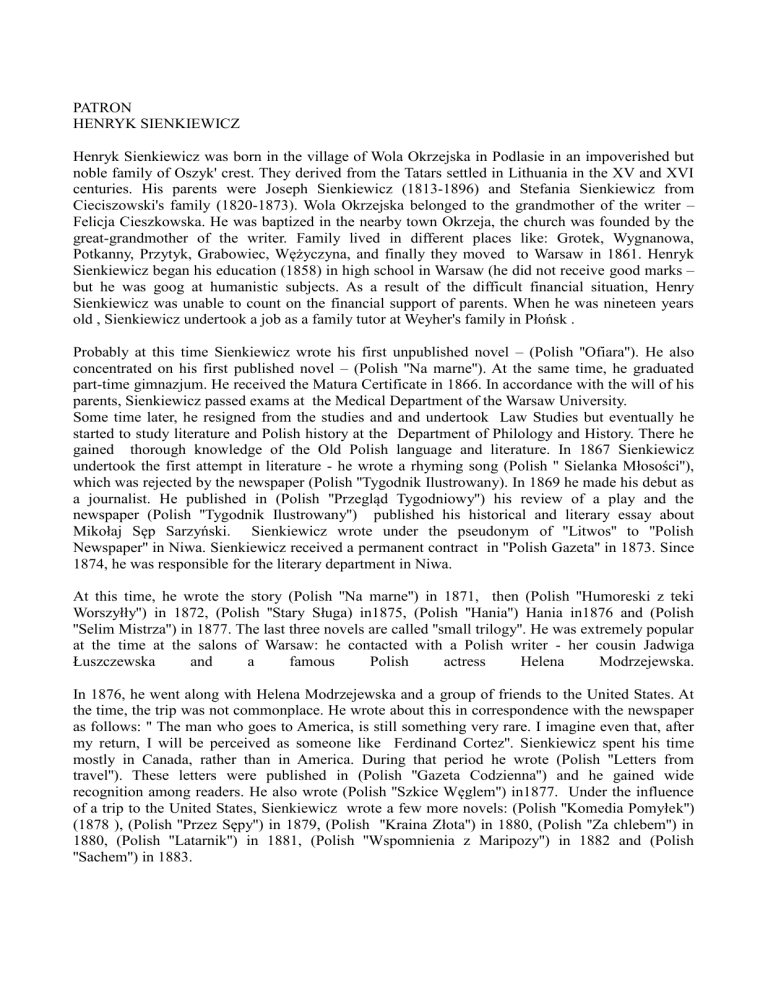
PATRON
HENRYK SIENKIEWICZ
Henryk Sienkiewicz was born in the village of Wola Okrzejska in Podlasie in an impoverished but noble family of Oszyk' crest. They derived from the Tatars settled in Lithuania in the XV and XVI centuries. His parents were Joseph Sienkiewicz (1813-1896) and Stefania Sienkiewicz from
Cieciszowski's family (1820-1873). Wola Okrzejska belonged to the grandmother of the writer –
Felicja Cieszkowska. He was baptized in the nearby town Okrzeja, the church was founded by the great-grandmother of the writer. Family lived in different places like: Grotek, Wygnanowa,
Potkanny, Przytyk, Grabowiec, Wężyczyna, and finally they moved to Warsaw in 1861. Henryk
Sienkiewicz began his education (1858) in high school in Warsaw (he did not receive good marks – but he was goog at humanistic subjects. As a result of the difficult financial situation, Henry
Sienkiewicz was unable to count on the financial support of parents. When he was nineteen years old , Sienkiewicz undertook a job as a family tutor at Weyher's family in Płońsk .
Probably at this time Sienkiewicz wrote his first unpublished novel – (Polish ''Ofiara''). He also concentrated on his first published novel – (Polish ''Na marne''). At the same time, he graduated part-time gimnazjum. He received the Matura Certificate in 1866. In accordance with the will of his parents, Sienkiewicz passed exams at the Medical Department of the Warsaw University.
Some time later, he resigned from the studies and and undertook Law Studies but eventually he started to study literature and Polish history at the Department of Philology and History. There he gained thorough knowledge of the Old Polish language and literature. In 1867 Sienkiewicz undertook the first attempt in literature - he wrote a rhyming song (Polish '' Sielanka Młosości''), which was rejected by the newspaper (Polish ''Tygodnik Ilustrowany). In 1869 he made his debut as a journalist. He published in (Polish ''Przegląd Tygodniowy'') his review of a play and the newspaper (Polish ''Tygodnik Ilustrowany'') published his historical and literary essay about
Mikołaj Sęp Sarzyński. Sienkiewicz wrote under the pseudonym of ''Litwos'' to ''Polish
Newspaper'' in Niwa. Sienkiewicz received a permanent contract in ''Polish Gazeta'' in 1873. Since
1874, he was responsible for the literary department in Niwa.
At this time, he wrote the story (Polish ''Na marne'') in 1871, then (Polish ''Humoreski z teki
Worszyłły'') in 1872, (Polish ''Stary Sługa) in1875, (Polish ''Hania'') Hania in1876 and (Polish
''Selim Mistrza'') in 1877. The last three novels are called ''small trilogy''. He was extremely popular at the time at the salons of Warsaw: he contacted with a Polish writer - her cousin Jadwiga
Łuszczewska and a famous
Polish actress Helena Modrzejewska.
In 1876, he went along with Helena Modrzejewska and a group of friends to the United States. At the time, the trip was not commonplace. He wrote about this in correspondence with the newspaper as follows: " The man who goes to America, is still something very rare. I imagine even that, after my return, I will be perceived as someone like Ferdinand Cortez''. Sienkiewicz spent his time mostly in Canada, rather than in America. During that period he wrote (Polish ''Letters from travel''). These letters were published in (Polish ''Gazeta Codzienna'') and he gained wide recognition among readers. He also wrote (Polish ''Szkice Węglem'') in1877. Under the influence of a trip to the United States, Sienkiewicz wrote a few more novels: (Polish ''Komedia Pomyłek'')
(1878 ), (Polish ''Przez Sępy'') in 1879, (Polish ''Kraina Złota'') in 1880, (Polish ''Za chlebem'') in
1880, (Polish ''Latarnik'') in 1881, (Polish ''Wspomnienia z Maripozy'') in 1882 and (Polish
''Sachem'') in 1883.
He returned to Europe in 1878, he stopped in London and then he spent a year in Paris. During his stay, Sienkiewicz started to study the new trend in the literature – naturalism. Henryk Sienkiewicz, in an article from Paris, presented the current literature trend in positive tones in 1879. He said: "
For a novel, naturalism was generally excellent, essential and can make only a step forward." Two years later, he changed his mind connected with the subject and spoke about naturalism in a very critical way. Expression of beliefs about naturalism are expressed in such works as: (Polish ''O naturaliźmie w p o w i i e ś ś c i i ' ' ' ' ) ) , , i i n ( ( P o l l i i s s h ' ' ' ' O p o w i i e ś ś c i i h i i s t t o r r y c z n e j j ' ' ' ' ) ) i i n 1 8 8 1 a n d i i n ( ( P o l l i i s h ' ' ' ' L i i s s t t y o
Z o l l i i ' ' ' ' ) ) i i n 1893.
Sienkiewicz's stay in America and correspondences, which were published in the Polish press, gained huge recognition and aroused interest in Sienkiewicz. The success of the great writer was noted by Bolesław Pus in the article in (Polish newspaper ''Kurier Warszawski) in 1880 – Henryk
Sienkiewcz became an extremely popular writer.
In 1879 Sienkiewicz gave a lecture in Lwów under the title ''From New York to California''. In
1880, in Poznan he read the Bazar Hotel the short story (Polish ''Za chlebem'') and then he gave his two readings of naturalism in literature. In 1879 returning from Lwów, in Szczawnica, he gave a lecture of his stay in America. There in Szczawnica, he saw for the first time his wife- Maria
Szetkiewiczówna . There he found out that the whole Szetkiewiczowie's family was to visit Venice and Sienkiewicz decided to go with them. Henryk Sienkiewicz got married Maria on 18 th
August
1881. The wedding took place in a church belonging to the Congregation of Maidens Canonesses on Theatre Square (today the church does not exist). From this marriage came children: Henry
Joseph and Jadwiga Maria. The marriage did not last long, Maria died on 18th August 18 1885.
Sienkiewicz started to cooperate with the newspaper (Polish ''Słowo) in 1882, where he wrote about trends in conservative tendencies). He worked ther as the main editor. Meanwhile, he wrote the dramatic work (Polish ''Na jedną kartę''), which was performed in theaters in Lwów and Warsaw
(1879-1881).
In 1880, Henryk Sienkiewicz wrote the historic novel (Polish ''Niewola Tatarska''), during his time he was working on a historical novel (Polish ''Ogniem i mieczem''). In a letter to the editor
(Stanisław Smolka) of the newspaper (Polish ''Czas'') in Krakow, Sienkiewicz described specific details of the novel. The novel was publishes in different Polish newspapers.
The novel (Polish ''Ogniem i mieczem''), just like another part of the trilogy, brought the writer a great appreciation and met with extraordinary social acceptance. Many people asked Sienkiewicz about history of their favorite heroes. One of the street in a city (Polish Zbraż) was name
''Sienkiewicz'' in 1879. The novel became very popular and arose different moral and historical feelings.
The writer began to work on another part of the Trilogy (Polish ''Potop''). The title was the author's indication on the flood of the masses, which drove the invaders from their homeland. Polish “Potop'' was printed in the newspaper (Polish ''Słowo'') from 23rd December 1884 to 2 nd September 1886.
During the work on the novel, Sienkiewicz's died because of tuberculosis.
The novel quickly won the hearts of readers and confirmed the position of the writer in society.
After the death of the writer's wife, Sienkiewicz went on an expedition to Constantinople (through
Bucharest and Varna), where he wrote correspondence. After returning to Warsaw, Sienkiewicz presented the third part of the trilogy (Polish ''Pan Włodyjowski''). The novel was printed in the newspaper (Polish '' Czas'') from May 1887 to May 1888. The trilogy was Sienkiewicz's heights of popularity and made him the most popular Polish writer. Sienkiewicz received in recognition of his literal work 15,000 rubles from an unknown admirer, who signed himself as Michael
Wolodyjowski. Sienkiewicz gave the money to support the foundation of Maria Sienkiewicz for
artists who were endangered by tuberculosis .
Henryk Sienkiewicz travelled to Spain in 1888, He returned in 1890 for the celebration of
Mickiewicz's year. At the end of 1890, Sienkiewicz embarked on a journey to Africa. Travel resulted in creating (Polish ''Listy z Afryki''). In 1891 he published a book edition (Polish ''Bez dogmatu''). The book was printed earlier from 1889 to 1890 in the pages of newspaper (Polish ''
Słow''). In 1892 Sienkiewicz signed a contract for a novel (Polish ''Rodzina Połanieckich''). The book edition was published in 1895. In summer 1894 in Zakopane, Sienkiewicz read excerpts from the next book connected with Polish history (Polish ''Krzyżacy''). In 1893, the writer began the preparation for the novel (Polish ''Quo Vadis''). The late eighties and early nineties – were for the writer time of extremely hard work over a number of novels.
In Sienkiewicz's private life appeared Maria Romanowska, who was an adopted daughter of a rich man Wołodkowicza Odessa. Sienkiewicz went to Odessa for the engagement. The wedding took place on 11 th November 1893 but very soon she left Sienkiewicz. Sienkiewicz obtained from the
Pope the confirmation of non-existence of the sacrament of marriage .
In February 1895, Sienkiewicz wrote the first chapters of ''Quo Vadis'' – the preparatory work as collecting materials, started in 1893. The novel began to appear in print in March 1895 in newspapers (Polish ''Gazeta Polska'' in Warsaw and in Polish ''Czas'' in Kraków and in Poznań in
Polish ''Dziennik Poznański''. This ended with a show in late February 1896. The book edition of
''Quo Vadis'' appeared very quickly. The novel quickly gained recognition and did an outstanding career in Europe. At present the book enjoys a unique popularity. The book was translated into many languages, even in such exotic as Arabic or Japanese as well as Esperanto. The popularity of
''Quo Vadis'' at the time, was evidenced by the fact that the names of the characters were given to horses competing in the race the Grand Prix de Paris. The novel was adapted and staged on the boards of theaters, appeared even opera based on the novel. In 1913, Quo Vadis was filmed. Then the novel was filmed several times .
In 1900, the writer celebrated his jubilee of creative work, which took place in an atmosphere of involvement of the whole society.The writer received from the public, property in Oblęgorek, where he created a nursery school for children. In the same yea, the Jagielloński University in
Cracow, conferred him with the honorary doctorate. Sienkiewicz involved in social issues. In 1900, he wrote a manifesto connected with children in Września (there was the place when Polish children were almost killed by Russians). In 1906, he called his countrymen from the U.S. to help the starving people in the Polish Kingdom (there was the part of Polish land, which were under annexation).
In 1904, he married the cousin 's niece Maria.
In 1905 he received the Nobel Prize for lifetime achievement. In a speech on this occasion, which was expressed by Sienkiewicz, he said that the honor is particularly valuable for the son of Poland.
" It was said that Poland was defeated and behold. My work is one of thousandths of evidence that
Poland is still alive ." He added “Poland was proclaimed to be conquered , and here's new evidence that Poland can fight.''
Sienkiewicz wrote (Polish ''Na polu Chwały'') during 1903-1909, which was to be the beginning of a new trilogy.
Sienkiewicz published the new book in the newspaper (Polish ''Kurier Warszawski'') in parts which was titled (Polish ''W pustyni i w Puszczy'') – the book was addressed to young people and children.
After the outbreak of the First World War, Sienkiewicz left to Switzerland. He was, together with
Ignacy Jan Paderewski, the founder of the Swiss General Committee to Aid Victims of War in
Poland. Sienkiewicz died in Vesey, on 15 th November 1916, where he was buried. In 1924 , when
Poland was a free country, the ashes of the writer were solemnly filed in Warsaw Cathedral of St.
John.

